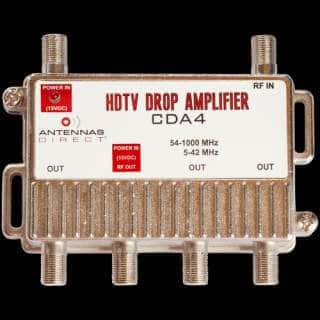
More power isn’t always the answer. Sometimes, with TV antennas, it can even get in the way. Many indoor TV antennas that are sold today come with an amplifier. If you are like most people, you will assume that this will improve your antenna reception and possibly help your television receive more channels. This isn’t always the case. In fact, most of the time, it doesn’t help in all. Sometimes, it can even make a channel’s signal too strong for the TV and not come in at all.
What an Antenna Amplifier Does
Generally, antenna amplifiers are typically referred to in two categories, preamplifiers and distribution amplifiers. Both perform the same function of boosting the signal strength (and noise) received by the antenna. The difference between them is really about the intended use.
A preamplifier‘s job is to be installed close to the antenna and boost the overall signal to overcome a long cable run. These are usually weatherproof to be installed outside near the antenna.
A distribution amplifier boosts the signal (and the noise) to send the signal to multiple receivers (televisions.) Putting an amplifier before a splitter serves is essentially a distribution amplifier. However, distribution amps also come in the form of a powered amplified splitter. Distribution amplifiers are typically designed to be used indoors.

Before digital television, the signals were analog. The stronger the signal, the more detail and better receptions a TV would receive. That isn’t true with digital television. Digital television either comes in, or it doesn’t. If a channel’s signal is above the threshold of being picked up by a TV, making that signal stronger isn’t going to improve the picture’s quality. In fact, if the signal is too strong, the TV turner overload and not be able to display the channel. Don’t worry. While overload is usually a bad word in electronics, it means the signal is over an acceptable strength threshold in this case.
Ultimately, an amplifier isn’t going to help you receive a signal that isn’t already reaching your antenna. However, it can boost the signal to make it through a long cable run or overcome a splitter to supply more than one TV with reception. Generally, an RG6 coaxial cable will lose an average of 5 dB of signal per 100 ft. Amplifiers are also very helpful when splitting a signal as a splitter will lose about 3.5 dB of signal per split.
What About Indoor Antenna Amplifiers
This brings me to the reason for this article. The type of amplifiers that come packaged with indoor antennas serves little purpose in most cases. Generally, they are designed to be installed closer to the television. This means all the noise and signal strength travel all the way down the cable, and both are amplified just before they hit the television. This makes little sense as any signal loss between the antenna and amplifier has already occurred. If the signal made it this far, it should be received by the TV already.
So why include these amplifiers with indoor antennas? My guess is that it’s an old holdover from analog TV days based on the assumption that more power is better. My advice is when installing an indoor antenna, install it without the amplifier first. If you feel you should be getting more channels, try the amplifier and see what happens. Of course, if you have a long cable run between the antenna and TV, install the amplifier at the antenna end and not the TV end. And if you are using a splitter, I’d consider using an outdoor antenna for the best results.
